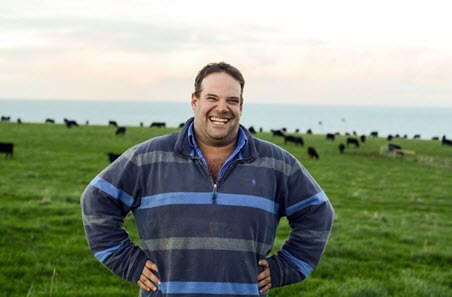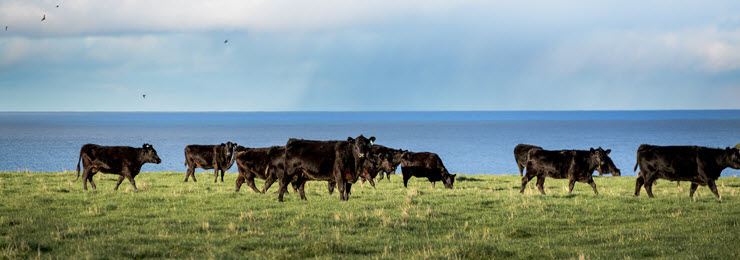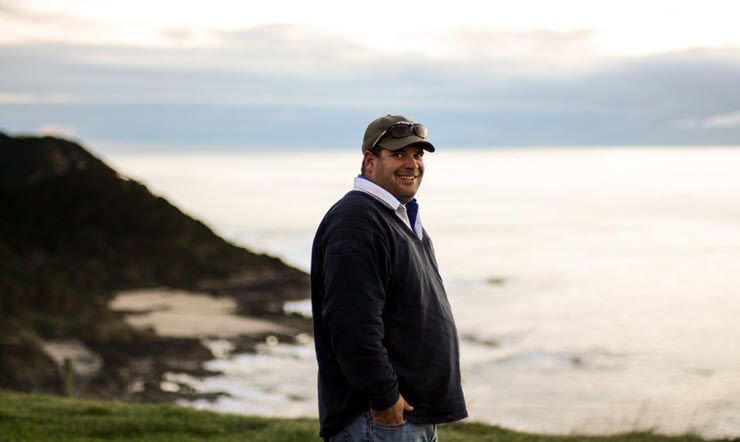Planning for growth
21 March 2019
Waverley Station’s King Island operations manager Jamie Roebuck is implementing simple strategies to build resilience and increase productivity in his intensive grazing enterprise.

Jamie oversees 10,000ha, 8,000 Angus breeders and 12 staff across four farms on King Island for the family-run company, which also has properties in NSW.
His business plan is founded on three principles:
- Focus on the ‘low hanging fruit’ of soil fertility and grazing management.
- Invest heavily in staff training.
- Match production systems to pasture supply.
“When it comes to developing a business plan, you have to assess what’s best for your individual situation,” he said.
“If you start with the basics and get the profit drivers right, the rest will start to fall into place.”
Jamie and his team concentrate on what’s within their control, such as adjusting production focus to reflect the environment.
One example of this approach was in 2017, when the 2018 turn-off of 3,700 steers (weighing 400–500kg) was sold to backgrounders in Tasmania from November 2017 to February 2018. This replaced their traditional pathway of sending 500–600kg steers direct to processing.
“We’ve always had a strong relationship with (processors) Greenhams and, although fewer cattle will now be going direct to slaughter, our steers are being purchased by some of their finishers,” Jamie said.
The decision to turn stock off earlier and lighter was motivated by knowledge gained from the MLA-supported Pasture Principles program, and supported by business analysis conducted with John Francis of Holmes and Sackett. John manages the King Island grazing benchmarking group, of which Jamie is a member.
“Analysing our business and assessing profit drivers showed us we could better match our production systems to our environment by turning stock off earlier to relieve grazing pressure through winter and increase kilos of beef producer per hectare annually," Jamie said.
“The Pasture Principles program completely changed how we manage our grass to match animal nutrition requirements to feed supply.
“At the end of the day, we’re just as much about farming and using grass as we are about producing beef."
Whole-of-business focus
King Island may be remote, but it plays an important role within the family company.
The decision to sell young stock before winter supported an additional 2,000 head in the past 12 months, sent down from Waverley Station’s drought-affected Scone and Gunnedah properties.
The business has been in a growth phase for the past 10–15 years, so 90% of heifers are retained as replacements. As the herd stabilises, surplus heifers will be used to rebuild the Scone herd once the drought breaks. Jamie also sees potential to sell heifers which have been pregnancy-tested in calf.

Pasture management
Soil and rainfall vary across King Island, from lighter breeding country with 850mm rainfall in the north to heavier finishing country with 1,000mm rainfall in the south.
Stocking rates range from 22 DSE/ha for breeders to 18 DSE/ha for young cattle.
Pasture management changes included increasing mob size to extend the grazing rotation from 30 to 60 days during winter, giving ryegrass-clover pastures more time to rest and recover (rotation length decreases as it warms up to match rotation periods to leaf emergence rates).
Jamie hopes the amended grazing management will support 15–20% more breeders.
It’s halved the amount of country under grazing pressure at any one time, leaving a lot more in recovery and growth phase. As well as increasing production, the new grazing management plan has reduced labour because there are fewer mobs to shift.

Productivity-boosting strategies
Grazing management is supported by an autumn nitrogen-based fertiliser program to build the winter feed wedge, supplemented by strategic urea application to bridge feed deficits.
Extensive soil testing helps manage applications targeting the huge variation in soil fertility within and between properties.
“We've been able to reduce inputs on the really good areas and use that money to rebuild levels on the country that was lacking, by strategically managing fertiliser inputs rather than blanket application,” Jamie said.
An intensive animal health program is necessary to manage the worm burden in the high rainfall environment and counteract soils which are deficient in many trace elements.
Productivity is also lifted through genetics, with bulls sourced from Waverley Station’s Angus stud at Scone. As well as delivering desired traits such as soundness, good growth and a moderate cow frame, this economically allows higher turnover of bulls to accelerate the rate of genetic gain.
Investing in people
A labour-intensive enterprise and the challenge of attracting and retaining skilled staff in a remote rural community means people are just as important as pastures.
“No business can be sustainable without profit, and at our scale it’s not possible without people,” Jamie said.
“My biggest driver is profit and my biggest consideration in achieving that is the impact on the team.
“I believe the more you invest in your staff, the more they give back. I enrolled all our staff on the island in the Pasture Principles program, and by having everyone ‘on board’ it’s been easier to implement the changes to our grazing.”

Strategies to increase labour efficiency include simple repeatable systems, technologies such as farm-management software and electronic data collection, and infrastructure such as laneways and well-designed yards.
Jamie has also lifted labour efficiency by adjusting breeder management.
He runs a strict six-week joining period, but calving is spread over eight weeks as heifers are joined two weeks earlier than cows to give first-calf breeders time to get back into calf the following year.
“For the past two years, we've scanned heifers into first and second cycle mobs and run them separately. This reduces labour during the calving period as we know which mobs will calve first and can monitor heifers accordingly," Jamie said.
Lessons learned
- review your business plan throughout the year to ensure targets are being met
- invest in people to build skills and foster ownership of ideas
- match production systems to the environment
- balance external advice with your own knowledge and experience
Resources:
- Soil fertility testing: agassist.com.au
- Benchmarking group: holmessackett.com.au
- Pasture Principles Program: macquariefranklin.com.au
- Farm management program: agriwebb.com
Jamie presented a case study on his farm business management strategy at the 2018 MLA-sponsored Tasmanian Red Meat Update. The 2019 event is on 26 July.
Find out more at redmeatupdates.com
More information:
Jamie Roebuck
E: jamieroebuck@waverleystation.com
waverleystation.com


